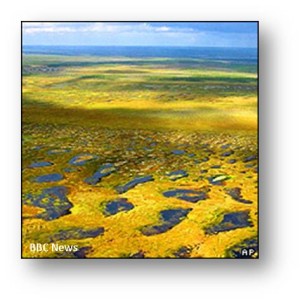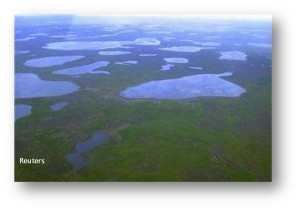
Melting permafrost, BBC News
Scientists in Siberia, Alaska and the Arctic are researching what happens when the tiny microbes, the residue of animals and plants that lived thousands of years ago, become exposed with melting that has been occurring with the warming of the planet. They have found that typically melting permafrost releases carbon dioxide.
In September 2006, a study found that the amount of carbon trapped in the type of permafrost found in Siberia is released at a rate five times faster than had been anticipated by scientists. Not only that, it was releasing 100 times the amount of carbon released into the air each year than that by the burning of fossil fuels. (Current global emissions of carbon from burning of fossil fuels, deforestation and other human activities total more than 10 billion tons per year.) Additionally, when permafrost at the bottom of Siberian lakes melts, it releases methane! Methane is a greenhouse gas 23 more powerful than carbon dioxide.
Once the permafrost begins to melt, the gases will be trapped in the earth’s atmosphere, thereby heating up the planet and melting more permafrost. Once this cycle begins, even if mankind were to eliminate release of carbon dioxide, the process of global warming would continue nonetheless.
Many studies are being conducted. A group of about 300 scientists is studying permafrost melting in the Arctic in the Arctic Climate Impact Assessment project. Another project, funded by the Department of Energy, the Next-Generation Ecosystem Experiments—Arctic, is employing 50 scientists to study the permafrost melting in Alaska. They will add environmental data gained from the study to a planetary model used to forecast how climate evolves under different emissions scenarios.
At the Toolik Field Station in northern Alaska a study is ongoing that is sponsored by the US National Science Foundation. This project will look at the effects of thermokarsts — the scars and pits left behind as melt water from permanently frozen ground leaks away, and soil and rock collapses in its wake. Scientists are also concerned with how release of oxygen, nitrogen and other nutrients will affect vegetation in newly melted regions.
Breck Bowden, scientist at the Toolik Field Station project says streams
are like blood vessels of the human body, and connect land, rivers and lakes, and ultimately the ocean. Streams are also important in their own right. For example, they nourish fish production, providing a key source of food for some communities. Only when we have a full understanding of what goes on in streams and their responses to disturbances will we be able to synthesize what goes on across the entire landscape.
At Hess Creek, Alaska a study conducted on what happens when chunks of Alaskan permafrost thaw for the first time in 1,200 years found there was an initial burst of methane after two days. After seven days, the methane concentration decreased significantly. The cause in the drop in two days was the increase of methane-eating microbes that continued to proliferate up to seven days. However, the samples emitted increasing amounts of carbon dioxide that did not decrease. The study, which continues, found that different microbes behave in unique ways and the release of gases can vary.

Melting Lakes in Siberia, Reuters
In general, when organic material comes out of the deep freeze, it is consumed by bacteria. If the material is well-aerated, bacteria that breathe oxygen will perform the breakdown, and the carbon will enter the air as carbon dioxide, the primary greenhouse gas. But in areas where oxygen is limited, like the bottom of a lake or wetland, a group of bacteria called methanogens will break down the organic material, and the carbon will emerge as methane.
References
Borenstein, S. (2006, September 7) Scientists Find New Global Warming ‘Time Bomb.’ Associated Press. Retrieved from: http://www.thewe.cc/weplanet/news/arctic/permafrost_melting.htm.
Gillis, J. (2011, December 16) As Permafrost Thaws, Scientists Study the Risks. New York Times. Retrieved from: http://www.nytimes.com/2011/12/17/science/earth/warming-arctic-permafrost-fuels-climate-change-worries.html?pagewanted=all.
Monastersky, R. (2011, December 11) Permafrost Science Heats up in the United States. Nature Magazine. Retrieved from: http://www.nature.com/news/permafrost-science-heats-up-in-the-united-states-1.9681.
Parry, W. (2011, November 6) Frozen Microscopic Worlds Come Alive as Earth Warms. Live Science. Retrieved from: http://www.livescience.com/16898-arctic-microbes-permafrost-climate-change.html
Qui, J. (2009, June 30) Observing the Scars of the Arctic Thaw. Nature Magazine. Retrieved from: http://www.nature.com/news/2009/090630/full/news.2009.609.html.

[…] permafrost melts, according to a scientists in Siberia, Alaska and the Arctic, it releases carbon dioxide. Carbon dioxide gets trapped as molecules in the permafrost, and when […]